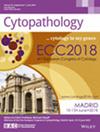Application of the international system for reporting serous fluid cytopathology on pleural effusion cytology with paired pleural biopsy: A new insight and novel approach on risk of malignancy
Abstract
Introduction
The risk of malignancy (ROM) remains an area of interest for further evaluation in reporting systems including in International System for reporting serous fluid cytopathology (TIS), which is a standardized system for reporting effusion cytology. Herein, we report our findings in further investigation of ROM in TIS by studying on paired pleural effusion specimens and corresponding pleural biopsies with emphasis on negative for malignancy, and atypia of undetermined significance categories.
Materials and Methods
The Johns Hopkins Hospital pathology database was retrospectively searched for patients with a pleural biopsy (PBX) and a paired pleural effusion (PF) cytology specimens over a 4-year period. We employed the TIS categories. The following statistical parameters were evaluated: sensitivity, specificity, positive predictive value (PPV), negative predictive value (NPV), and ROM.
Results
A total of 223 patient cases were included. Effusions TIS reclassification and ROM were as follows: 1.8% non-diagnostic (ROM 75%), 75.8% negative for malignancy (ROM 23%), 4.9% atypical cells of undetermined significance (ROM 45%), 2.2% suspicious for malignancy (ROM 80%), and 15.2% malignant (ROM 100%). Overall accuracy, sensitivity, specificity, PPV and NPV were calculated and were 79.4%, 45%, 97.7%, 91.2% and 77%, respectively. Among, discordant cases diagnosed negative for malignancy on PF and positive for malignancy on PBX, there were significant number of lymphomas, mesotheliomas, and sarcomas. Lung cancer was the most common carcinoma; however, rare types of carcinomas were noted. Cells blocks and immunohistochemistry (IHC) studies were utilized to confirm either malignant conditions or rule out malignancy in both cell blocks and histology biopsies.
Conclusion
This study demonstrates the high specificity and ROM for ‘malignant’ and ‘suspicious for malignancy’ categories in the TIS reporting system and highlights the modest negative predictive value for the ‘negative for malignancy’ category. Although Tissue biopsies are usually considered as ‘gold standard’, any definitive diagnosis of malignancy of body fluid should be considered positive for malignancy in further clinical decision-making.


 求助内容:
求助内容: 应助结果提醒方式:
应助结果提醒方式:


